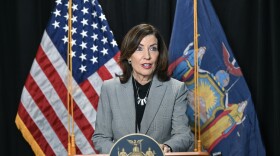At the Baldwinsville School District’s administrative office, Superintendent David Hamilton works from an office filled with reclaimed furniture. He says a fancy office chair doesn’t help teach students biology.
Hamilton says that sort of frugality is what helped Baldwinsville score one of the best “bang for the buck” ratings in a recent report by the Center for American Progress. It ranked high on a spending to test score ratio.
"It’s not as a result of any magic bullets. It’s a lot of little things," he said. "Like I always say, it’s about finding the nickels between the cushions, but if you do that in every part of the operation and you do that all the time, it actually turns out to be quite a bit in savings."
School districts all spend different amounts on their student’s education. It can vary by thousands of dollars in different corners of the state. The new report looks at just how efficient districts are with the money they’re spending.
The Center for American Progress tried to determine just how well dollars are being spent by districts. In some cases, more money spent per student did not translate into higher achievement ratings.
Baldwinsville spends $14,825 on each student. Some New York districts spend over $30,000.
The report found that wealthier districts are often more wasteful in their spending. And the center says priorities are off – like funding athletics over arithmetic – in some districts.
Hamilton says it’s also helpful that Baldwinsville is a mid-sized district (about 5,000 students), which allows it to offer a lot of programs and have enough kids to fill a school bus, but without a huge overhead. He calls it “The Goldilocks Zone.”
"And very small districts struggle because they want to offer those AP courses, they want to offer those great electives, but they only have four or five students," he said.
"Their cost to run that class is identical to our cost, but we can fit more students into the classroom because we have a larger tax base."
One of the higher spending districts in the state is LaFayette, though it’s also one of the smaller ones. It was in the red on the report’s efficiency scale.
There, business manager Tiffany Turner says spending is more complicated than just a number. That’s because the town, south of Syracuse, also oversees the Onondaga Nation school.
"Our district is very lucky," Turner said. "And when I said we’re unique, we’re very fortunate to have a school, in its entirety, funded through the state education department."
Turner says that state funding makes its funding numbers look inflated, because there’s some duplication in staffing to oversee the Onondaga Nation school. LaFayette spends $22,691 on each of its roughly 800 students.
"I think that we try to provide as many opportunities as possible for our students," she said.
Cazenovia schools received a good rating for its spending. But at $18,806 a student, East Syracuse-Minoa was given a poor ranking.
The Center for American Progress recommends, like Common Core provides a unified curriculum for all districts, a more consistent funding structure statewide is needed.







